The Reflectance of Human Skin in the Millimeter-Wave Band
Abstract
1. Introduction
2. Materials and Methods
2.1. Participants
2.2. Measurement Locations
2.3. Experimental Setup and Calibration
2.4. Reflectance Measurements
2.5. Reflectance Measurements for Wet Skin
2.6. Assessing the Significance Level of the Mean Differences in the Reflectance
3. Results
3.1. Reflectance Measurements for the Whole Sample
3.2. Reflectance Measurements for Female Participants
3.3. Reflectance Measurements for Male Participants
3.4. Comparison in Skin Reflectance between Female and Male Participants
3.5. Skin Reflectance for Female Participants Under Normal and Wet Skin Conditions
3.6. Skin Reflectance for Male Participants Under Normal and Wet Skin Conditions
4. Discussion
5. Conclusions
Author Contributions
Funding
Conflicts of Interest
References
- Yujiri, L.; Shoucri, M.; Moffa, P. Passive Millimeter-Wave Imaging. IEEE Microw. Mag. 2003, 4, 39–50. [Google Scholar] [CrossRef]
- Appleby, R. Passive millimetre-wave imaging and how it differs from terahertz imaging. Philos. Trans. A Math. Phys. Eng. Sci. 2004, 362, 379–392. [Google Scholar] [CrossRef] [PubMed]
- Harmer, S.W.; Bowring, N.; Andrews, D.; Rezgui, N.D.; Southgate, M.; Smith, S. A Review of Nonimaging Stand-Off Concealed Threat Detection with Millimeter-Wave Radar. IEEE Microw. Mag. 2012, 13, 160–167. [Google Scholar] [CrossRef]
- Goldsmith, P.; Hsieh, C.-T.; Huguenin, G.; Kapitzky, J.; Moore, E. Focal plane imaging systems for millimeter wavelengths. IEEE Trans. Microw. Theory Tech. 1993, 41, 1664–1675. [Google Scholar]
- Wiltse, J. History of millimeter and submillimeter waves. IEEE Trans. Microw. Theory Tech. 1984, 32, 1118–1127. [Google Scholar]
- Smulders, P. Analysis of human skin tissue by millimeter-wave reflectometry. Ski. Res. Technol. 2012, 19, e209–e216. [Google Scholar] [CrossRef] [PubMed]
- Owda, A.Y.; Salmon, N.; Harmer, S.W.; Shylo, S.; Bowring, N.J.; Rezgu, N.D.; Shah, M. Millimeter-wave emissivity as a metric for the non-contact diagnosis of human skin conditions. Bioelectromagnetics 2017, 38, 559–569. [Google Scholar] [CrossRef]
- Alekseev, S.I.; Szabo, I.; Ziskin, M.C. Millimeter wave reflectivity used for measurement of skin hydration with different moisturizers. Ski. Res. Technol. 2008, 14, 390–396. [Google Scholar] [CrossRef]
- Kharkovsky, S.; Ghasr, M.; Abou-Khousa, M.; Zoughi, R. Near-field microwave and mm-wave noninvasive diagnosis of human skin. In Proceedings of the International Workshop on Medical Measurements and Applications, Cetraro, Italy, 29–30 May 2009. [Google Scholar]
- Alekseev, S.I.; Ziskin, M.C. Human skin permittivity determined by millimeter wave reflection measurements. Bioelectromagnetics 2007, 28, 331–339. [Google Scholar] [CrossRef]
- Zhadobov, M.; Chahat, N.; Sauleau, R.; le Quement, C.; le Drean, Y. Millimeter-wave interactions with the human body: State of knowledge and recent advances. Int. J. Microw. Wirel. Technol. 2011, 3, 237–247. [Google Scholar] [CrossRef]
- Alekseev, S.I.; Radzievsky, A.A.; Logani, M.K.; Ziskin, M.C. Millimeter wave dosimetry of human skin. Bioelectromagnetics 2008, 29, 65–70. [Google Scholar] [CrossRef] [PubMed]
- Hagness, S.; Taflove, A.; Bridges, J. Three-dimensional FDTD analysis of a pulsed microwave confocal system for breast cancer detection: Design of an antenna-Array element. IEEE Trans. Antennas Propag. 1999, 47, 783–791. [Google Scholar] [CrossRef]
- Mehta, P.; Chand, K.; Narayanswamy, D.; Beetner, D.; Zoughi, R.; Stoecker, W. Microwave Reflectometry as a Novel Diagnostic Tool for Detection of Skin Cancers. IEEE Trans. Instrum. Meas. 2006, 55, 1309–1316. [Google Scholar] [CrossRef]
- Picetti, D.; Foster, S.; Pangle, A.K.; Schrader, A.; George, M.; Wei, J.Y.; Azhar, G. Hydration health literacy in the elderly. Nutr. Healthy Aging 2017, 4, 227–237. [Google Scholar] [CrossRef]
- Lavizzo-Mourey, R.J. Dehydration in the Elderly: A Short Review. J. Natl. Med. Assoc. 1987, 79, 1033–1038. [Google Scholar]
- Gao, Y.; Zoughi, R. Millimeter Wave Reflectometry and Imaging for Noninvasive Diagnosis of Skin Burn Injuries. IEEE Trans. Instrum. Meas. 2017, 66, 77–84. [Google Scholar] [CrossRef]
- Lubecke, O.B.; Nikawa, Y.; Snyder, W.; Lin, J.; Mizuno, K. Novel microwave and millimeter-wave biomedical applications. In Proceedings of the 4th International Conference, In Telecommunications in Modern Satellite, Cable and Broadcasting Services, Nis, Yugoslavia, 13–15 October 1999. [Google Scholar]
- Gabriel, S.; Lau, R.W.; Gabriel, C. The dielectric properties of biological tissues: III. Parametric models for the dielectric spectrum of tissues. Phys. Med. Biol. 1996, 41, 2271–2293. [Google Scholar] [CrossRef]
- Aminzadeh, R.; Saviz, M.; Shishegar, A.A. Dielectric properties estimation of normal and malignant skin tissues at millimeter-wave frequencies using effective medium theory. In Proceedings of the 22nd Iranian Conference on Electrical Engineering (ICEE), Tehran, Iran, 20–22 May 2014. [Google Scholar]
- Pickwell, E.; Fitzgerald, A.J.; Cole, B.E.; Taday, P.F.; Pye, R.J.; Ha, T.; Pepper, M.; Wallace, V.P. Simulating the response of terahertz radiation to basal cell carcinoma using ex vivo spectroscopy measurements. J. Biomed. Opt. 2005, 10, 064021. [Google Scholar] [CrossRef]
- Pickwell, E.; Cole, B.E.; Fitzgerald, A.J.; Pepper, M.; Wallace, V.P. In vivo study of human skin using pulsed terahertz radiation. Phys. Med. Biol. 2004, 49, 1595–1607. [Google Scholar] [CrossRef]
- Taeb, A.; Gigoyan, S.; Safavi-Naeini, S. Millimetre-wave waveguide reflectometers for early detection of skin cancer. Microw. Antennas Propag. IET 2013, 7, 1182–1186. [Google Scholar] [CrossRef]
- Chan, K.Y.; Ramer, R. Millimetre-wave near field probe for skin defects detection. In Proceedings of the International Conference on Electromagnetics in Advanced Applications (ICEAA), Turin, Italy, 7–11 September 2015. [Google Scholar]
- Owda, A.Y.; Salmon, N.; Shylo, S.; Owda, M. Assessment of Bandaged Burn Wounds Using Porcine Skin and Millimetric Radiometry. Sensors 2019, 19, 2950. [Google Scholar] [CrossRef] [PubMed]
- Owda, A.Y.; Owda, M.; Rezgui, N.-D. Synthetic Aperture Radar Imaging for Burn Wounds Diagnostics. Sensors 2020, 20, 847. [Google Scholar] [CrossRef] [PubMed]
- Wallace, V.P.; Fitzgerald, A.J.; Pickwell, E.; Pye, R.J.; Taday, P.F.; Flanagan, N.; Ha, T. Terahertz pulsed spectroscopy of human Basal cell carcinoma. Appl. Spectrosc. 2006, 60, 1127–1133. [Google Scholar] [CrossRef] [PubMed]
- Rohde & Schwarz, Measurement of Dielectric Material Properties. Berlin, 2012. Available online: https://cdn.rohde-schwarz.com/pws/dl_downloads/dl_application/00aps_undefined/RAC-0607-0019_1_5E.pdf (accessed on 5 December 2019).
- Zohra, Z.; Lanigan, S.W. Skin: Structure and Function. In Dermatology in Clinical Practice; Springer: London, UK, 2010; pp. 1–15. [Google Scholar]
- Xu, F.; Lu, T. Introduction to Skin Biothermomechanics and Thermal Pain; Springer: Berlin, Germany, 2011. [Google Scholar]
- Lee, Y.; Hwang, K. Skin thickness of Korean adults. Surg. Radiol. Anat. 2002, 24, 183–189. [Google Scholar] [PubMed]
- Derraik, J.G.B.; Rademaker, M.; Cutfield, W.S.; Pinto, T.E.; Tregurtha, S.; Faherty, A.; Peart, J.M.; Drury, P.L.; Hofman, P.L. Effects of Age, Gender, BMI, and Anatomical Site on Skin Thickness in Children and Adults with Diabetes. PLoS ONE 2014, 9, e86637. [Google Scholar] [CrossRef] [PubMed]
- Firooz, A.; Sadr, B.; Babakoohi, S.; Sarraf-Yazdy, M.; Fanian, F.; Kazerouni-Timsar, A.; Nassiri-Kashani, M.; Naghizadeh, M.M.; Dowlati, Y. Variation of biophysical parameters of the skin with age, gender, and body region. Sci. World J. 2012, 1–5. [Google Scholar] [CrossRef] [PubMed]
- Giacomoni, P.U.; Mammone, T.; Teri, M. Gender-linked differences in human skin. J. Dermatol. Sci. 2009, 55, 144–149. [Google Scholar] [CrossRef]
- Sandby-Møller, J.; Poulsen, T.; Wulf, H.C. Epidermal Thickness at Different Body Sites: Relationship to Age, Gender, Pigmentation, Blood Content, Skin Type and Smoking Habits. Acta Derm Venereol. 2003, 83, 410–413. [Google Scholar] [CrossRef]
- Robertson, K.; Rees, J.L. Variation in epidermal morphology in human skin at different body sites as measured by reflectance confocal microscopy. Acta Derm Venereol. 2010, 90, 368–373. [Google Scholar]
- Shuster, S.; Black, M.M.; Mcvitie, E. The influence of age and sex on skin thickness, skin collagen and density. Br. J. Dermatol. 1975, 93, 639–643. [Google Scholar] [CrossRef]
- Montagna, W.; Ebling, F.J.G. Human Skin. Encyclopædia Britannica, Inc., 11 April 2016. Available online: https://www.britannica.com/science/human-skin (accessed on 18 November 2019).
- Owda, A.Y.; Salmon, N.; Rezgui, N.-D. Electromagnetic Signatures of Human Skin in the Millimeter Wave Band 80–100 GHz. Prog. Electromagn. Res. B 2018, 80, 79–99. [Google Scholar] [CrossRef][Green Version]
- Owda, A.Y.; Salmon, N. Variation in the electromagnetic signatures of the human skin with physical activity and hydration level of the skin. In Proceedings of the SPIE 11164, Millimetre Wave and Terahertz Sensors and Technology XII, Strasbourg, France, 9–10 September 2019. [Google Scholar]
- Owda, A.Y.; Salmon, N.; Rezgui, N.-D.; Shylo, S. Millimetre wave radiometers for medical diagnostics of human skin. In Proceedings of the 2017 IEEE SENSORS, Glasgow, UK, 29 October–1 November 2017. [Google Scholar]
- Harmer, S.W.; Shylo, S.; Shah, M.; Bowring, N.J.; Owda, A.Y. On the feasibility of assessing burn wound healing without removal of dressings using radiometric millimetre-wave sensing. Prog. Electromagn. Res. M 2016, 45, 173–183. [Google Scholar] [CrossRef]
- Gray, H. Anatomy of the Human Body; Lea & Febiger: Philadelphia, PA, USA, 1981. [Google Scholar]
- Pozar, D.M. Microwave Engineering, 4th ed.; John Wiley & Sons: Hoboken, NJ, USA, 2011. [Google Scholar]
- Bardati, F.; Solimini, D. Radiometric sensing of biological layered media. Radio Sci. 1983, 18, 1393–1401. [Google Scholar] [CrossRef]
- Born, M.; Wolf, E. Principles of Optics, 7th ed.; Cambridge University Press: Cambridge, UK, 1999. [Google Scholar]
- Griffiths, C.; Barker, J.; Bleiker, T.; Chalmers, R.; Creamer, D. Rook’s Textbook of Dermatology, 9th ed.; Wiley-Blackwell: Oxford, UK, 2016. [Google Scholar]
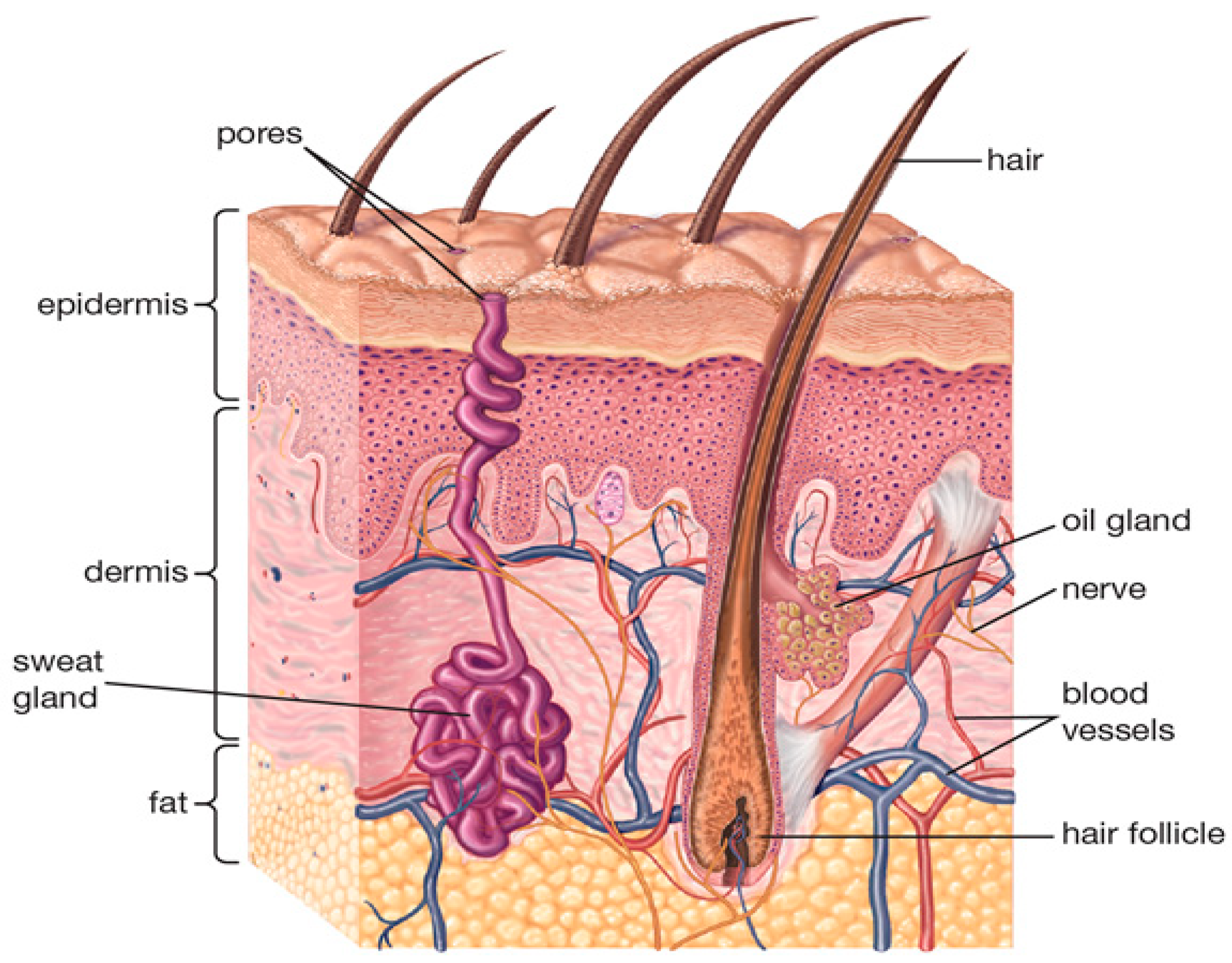
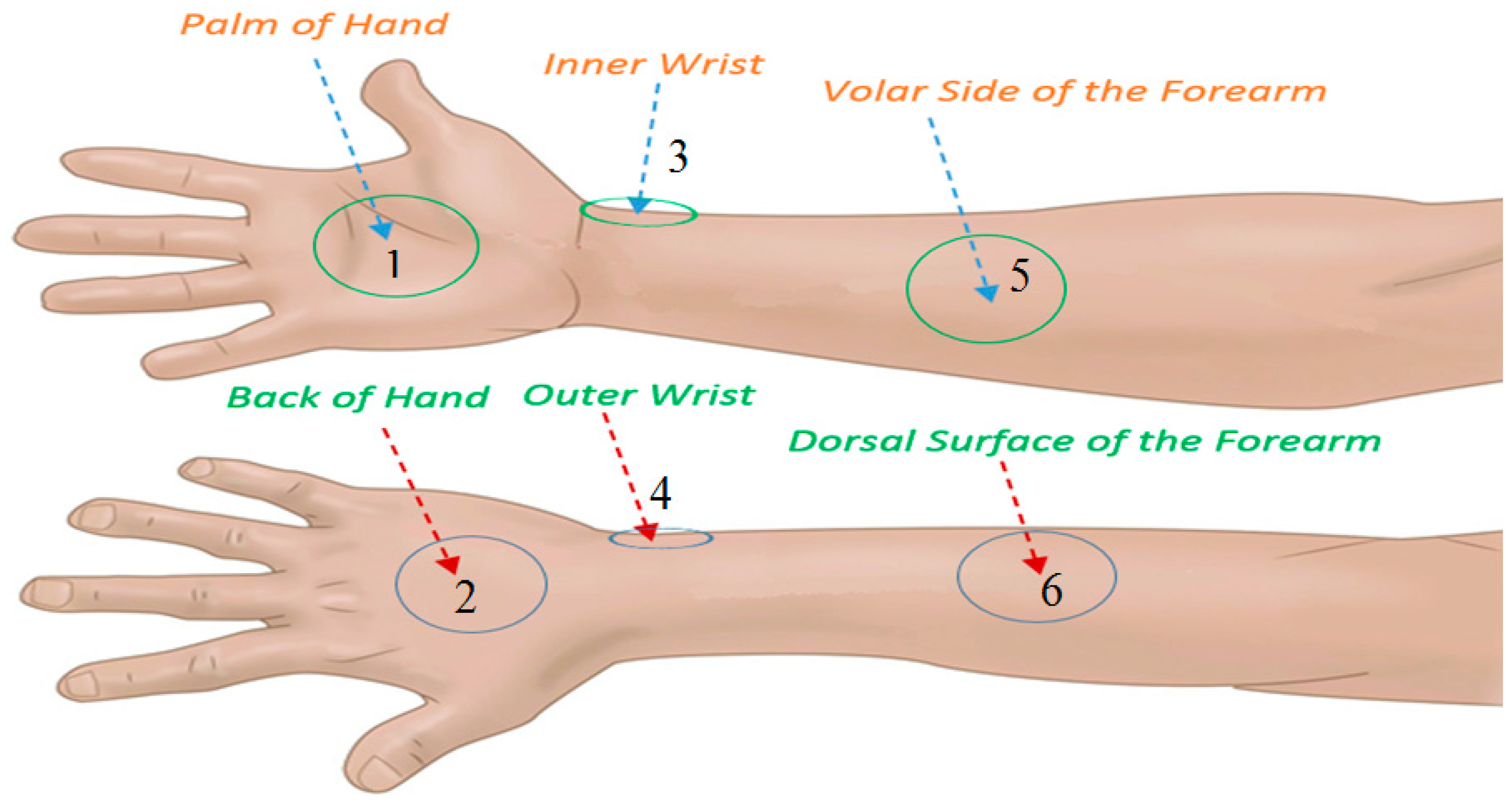
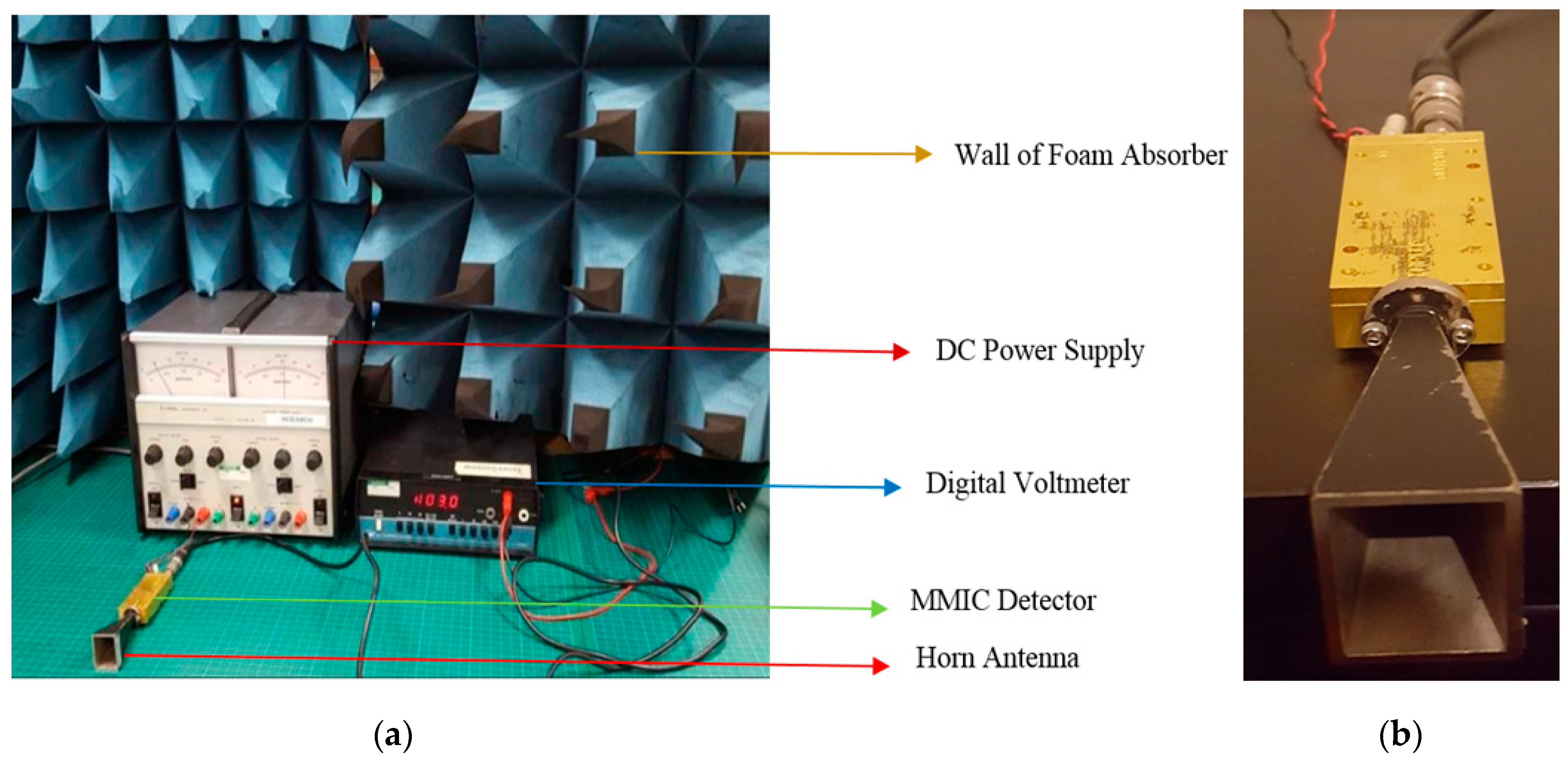
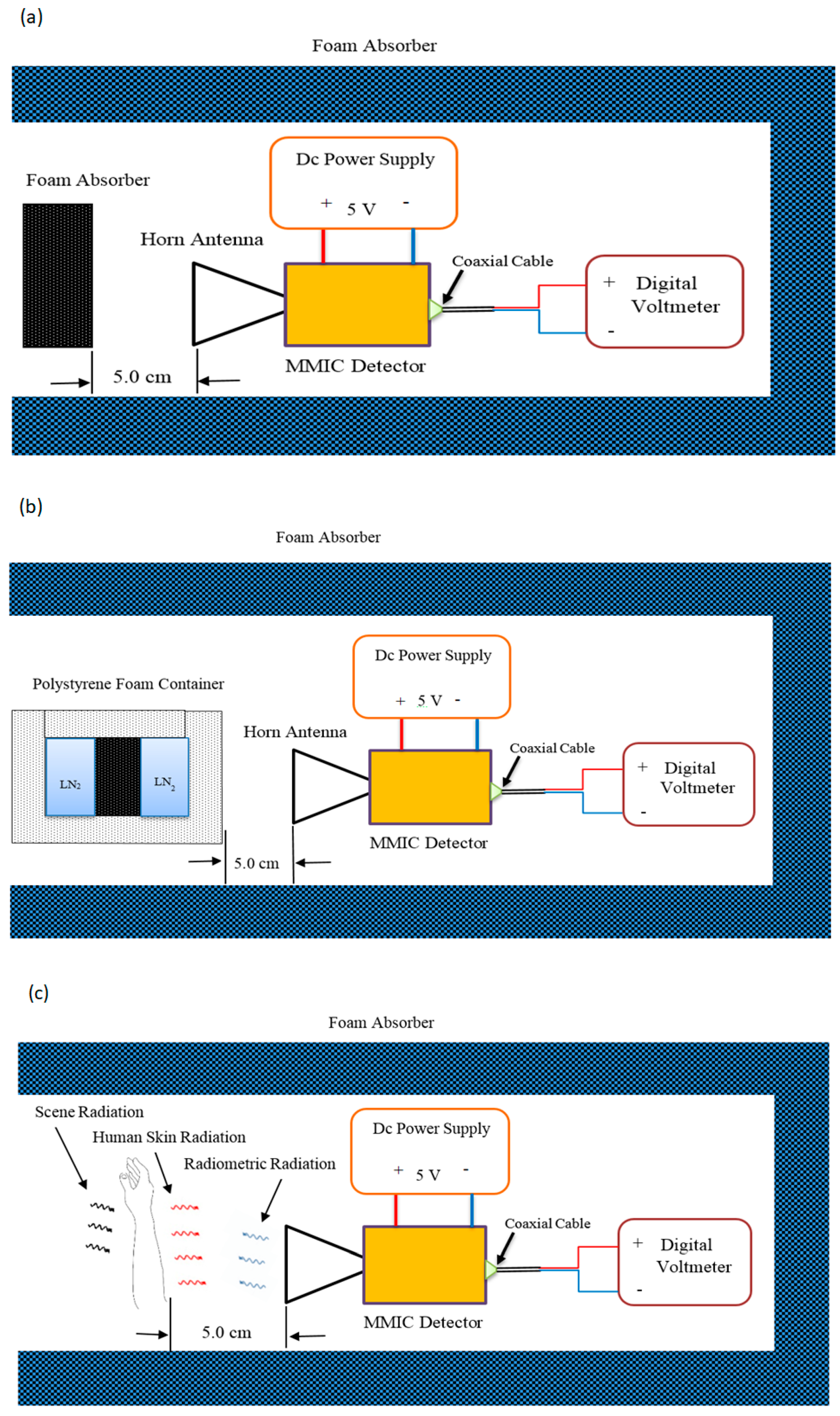
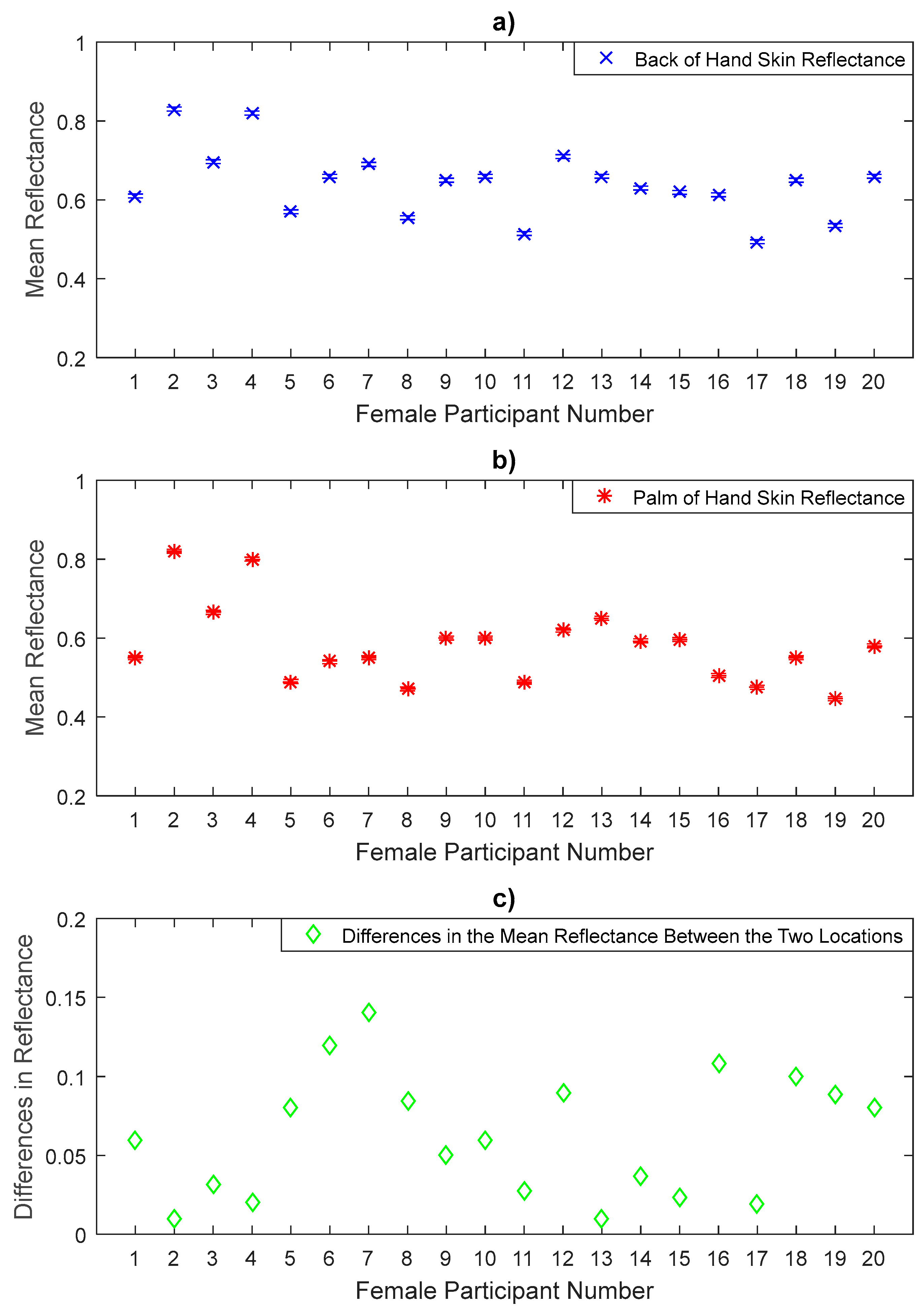
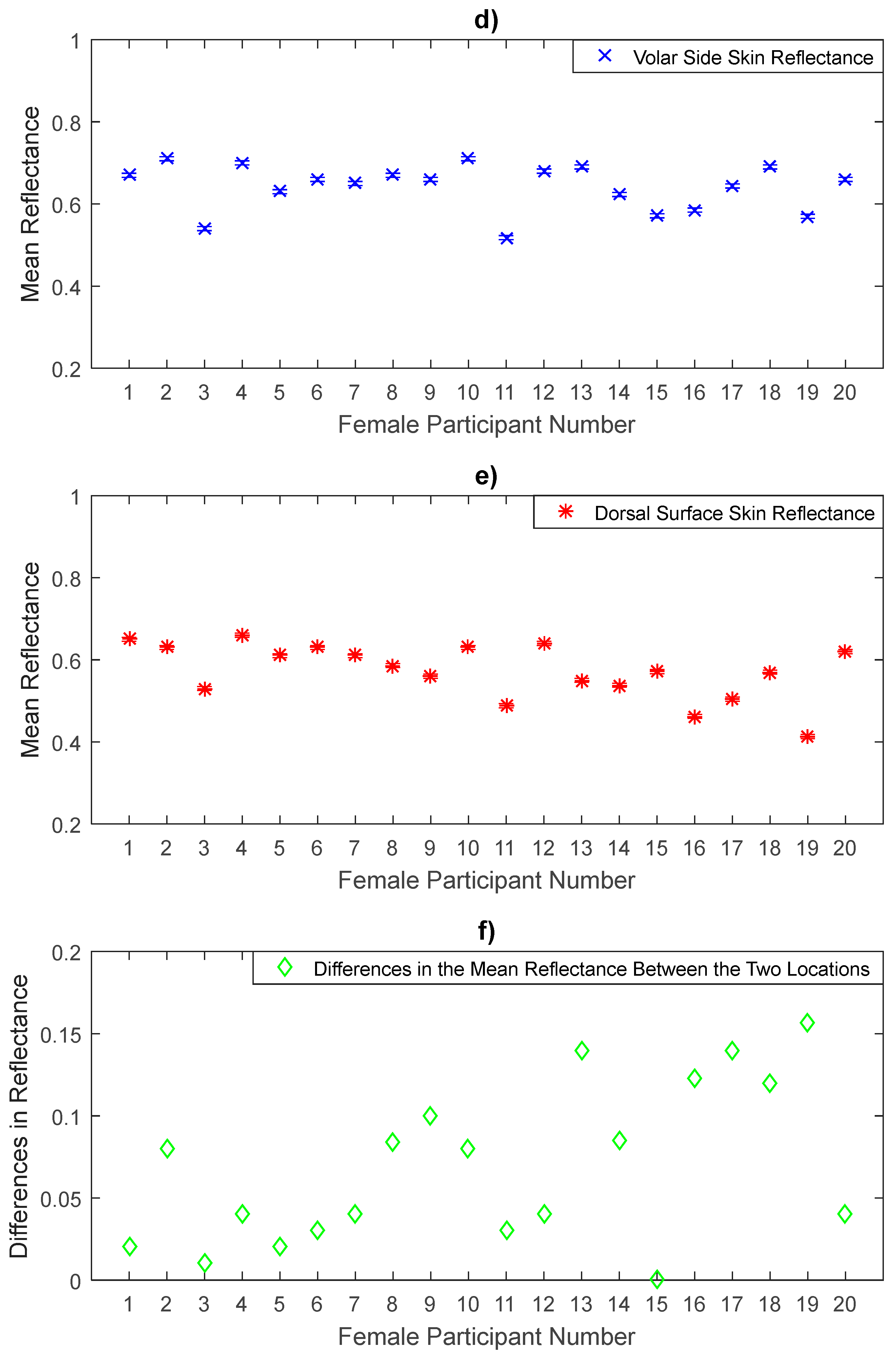

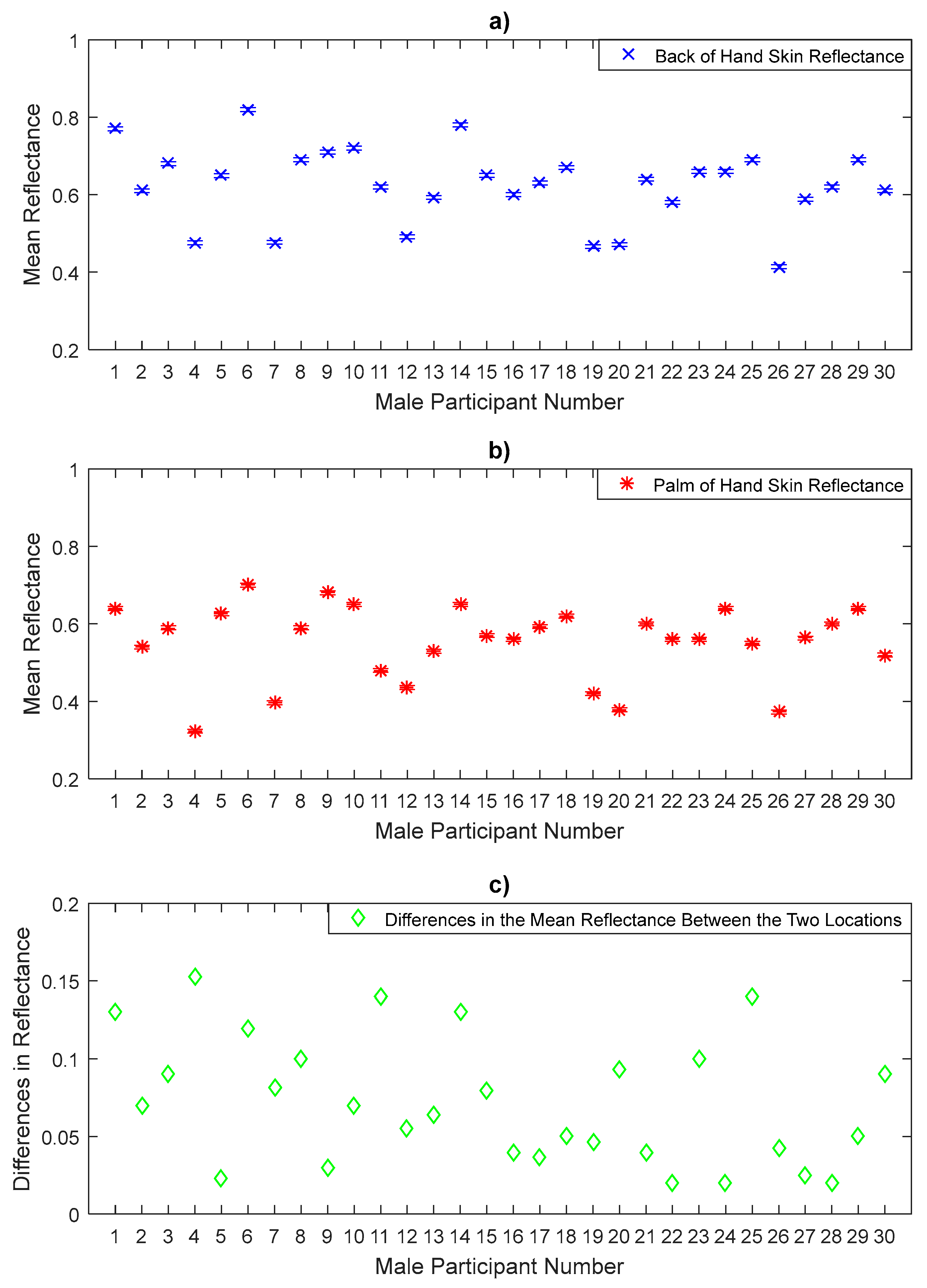
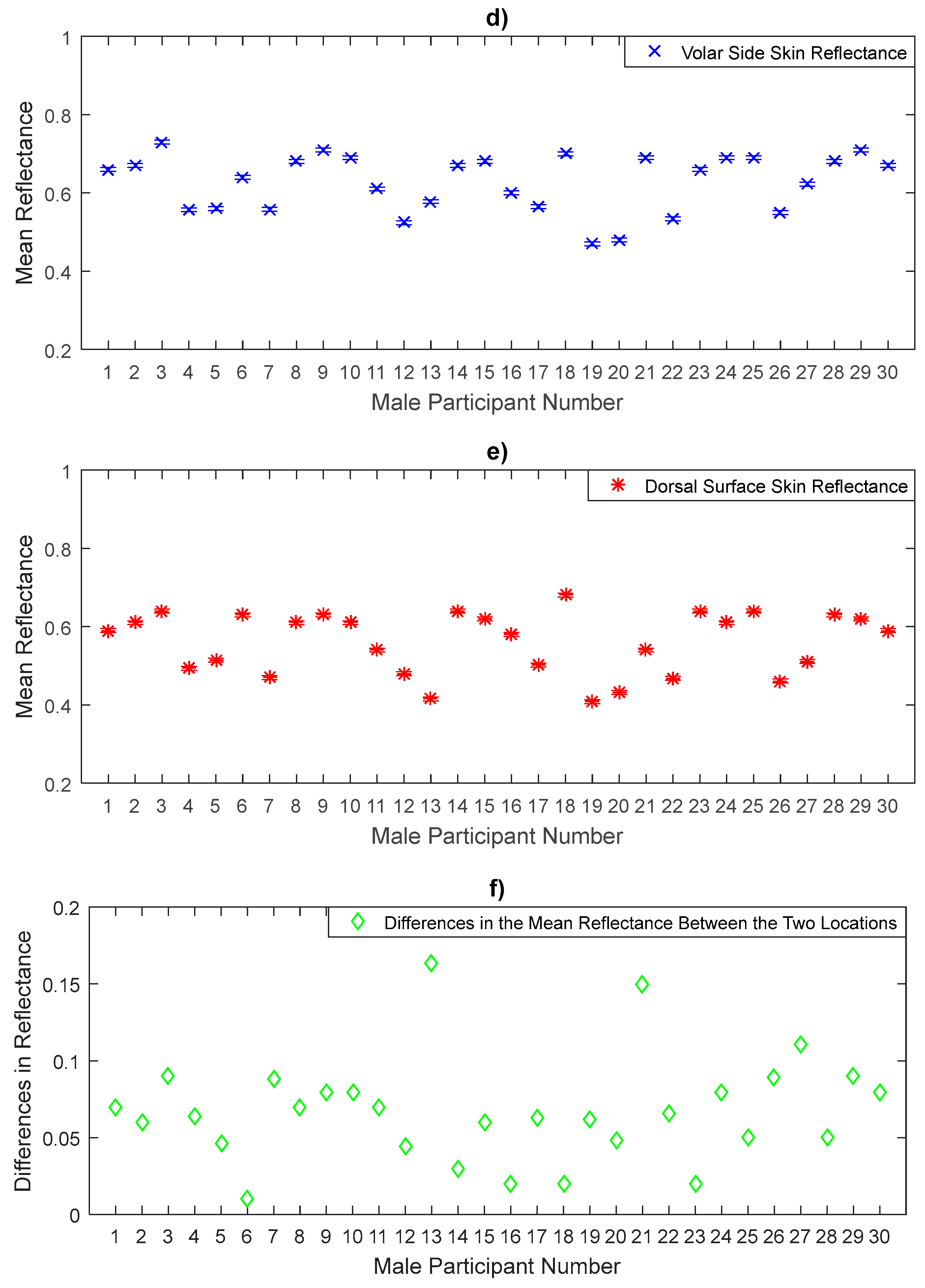
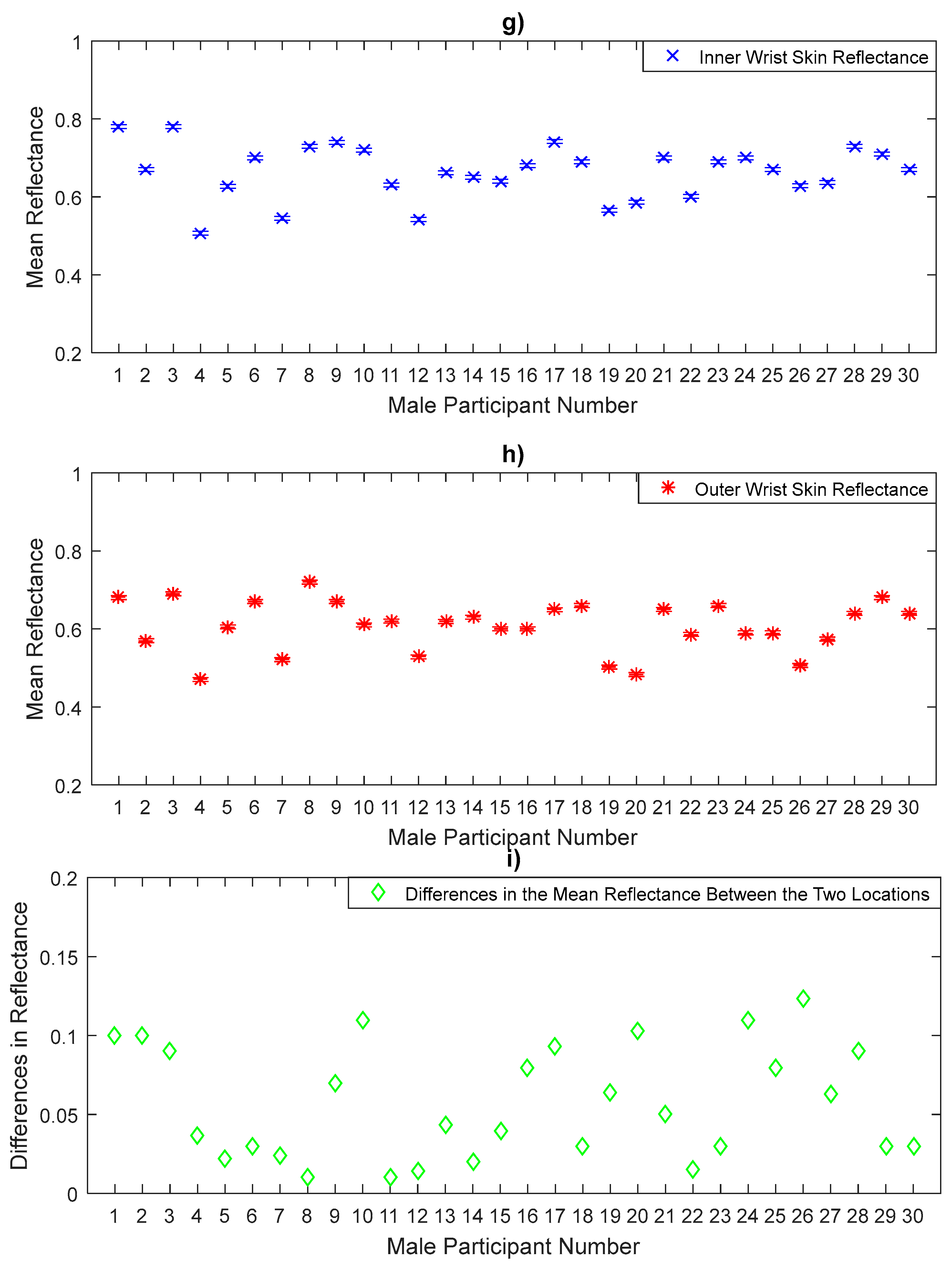
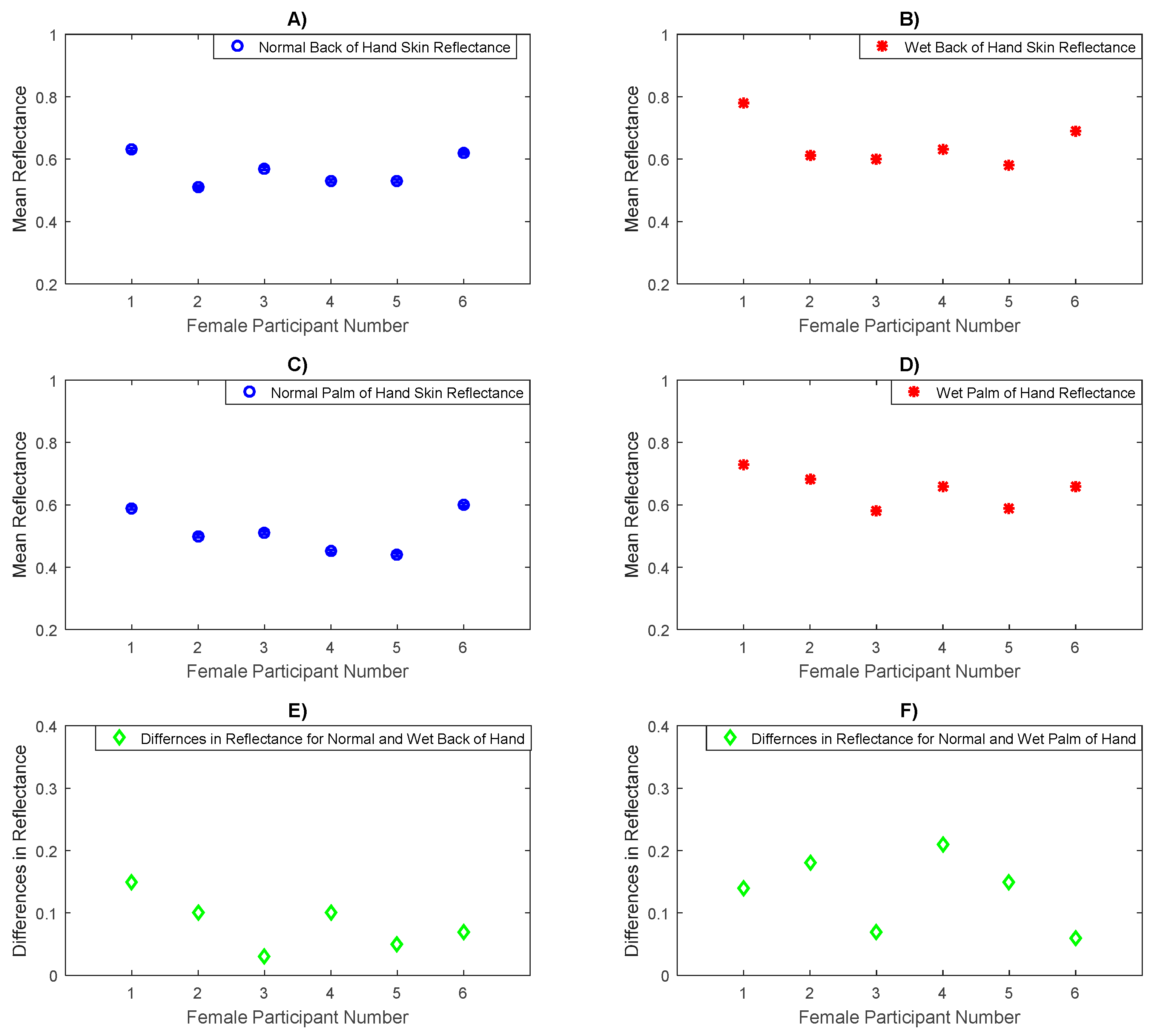
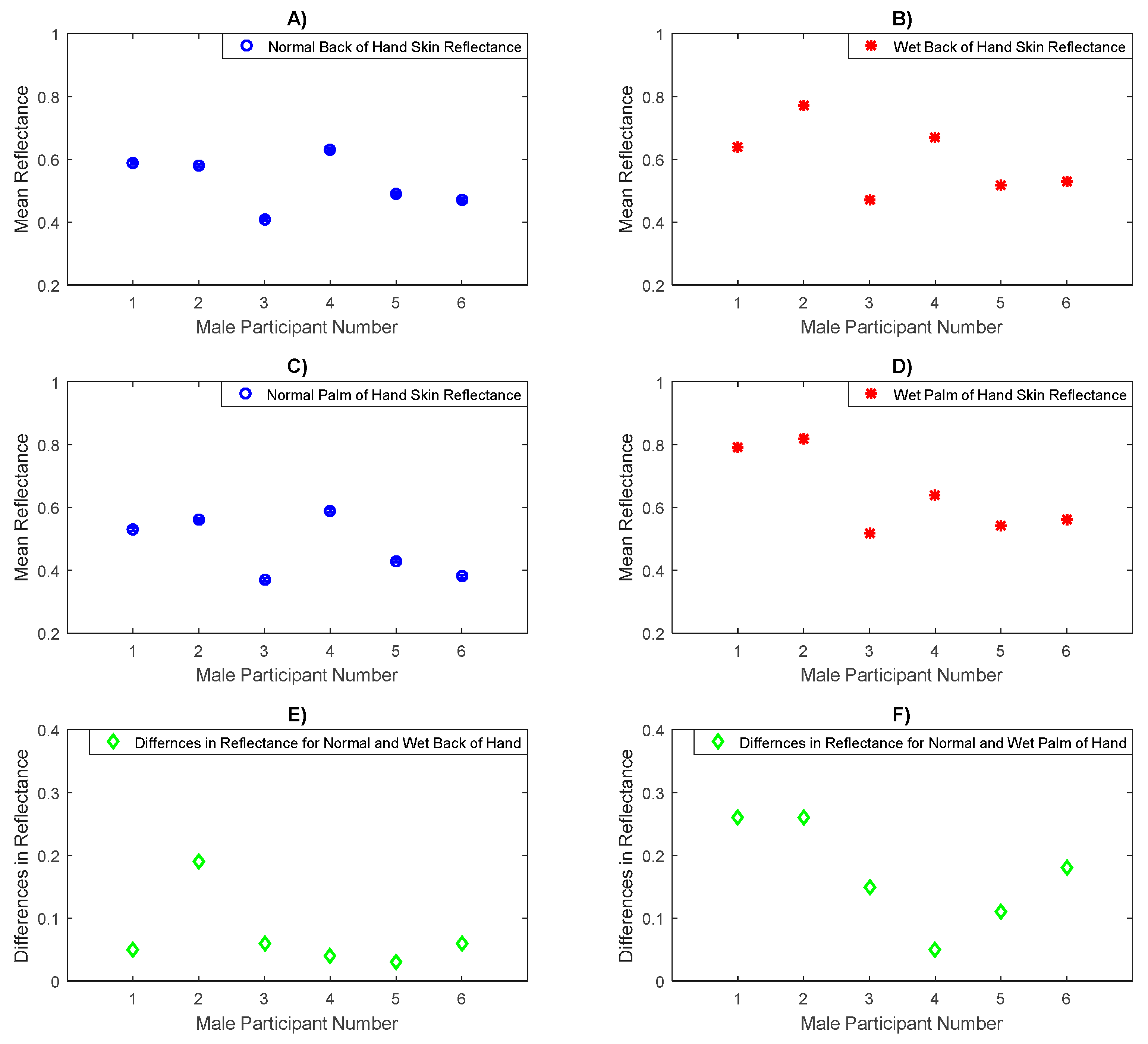
| Location | Mean | SD | SEM |
|---|---|---|---|
| The back of the hand | 0.631 | 0.093 | 0.013 |
| The palm of the hand | 0.563 | 0.097 | 0.014 |
| Volar side of forearm | 0.633 | 0.066 | 0.009 |
| Dorsal surface of forearm | 0.565 | 0.073 | 0.010 |
| Inner wrist | 0.680 | 0.065 | 0.009 |
| Outer wrist | 0.618 | 0.065 | 0.009 |
| All locations | 0.615 | 0.088 | 0.012 |
| Location | Mean Female | SD Female | Mean Male | SD Male |
|---|---|---|---|---|
| The back of the hand | 0.641 | 0.085 | 0.624 | 0.097 |
| The palm of the hand | 0.579 | 0.097 | 0.553 | 0.096 |
| Volar side of forearm | 0.641 | 0.055 | 0.628 | 0.072 |
| Dorsal surface of forearm | 0.573 | 0.066 | 0.560 | 0.078 |
| Inner wrist | 0.704 | 0.051 | 0.664 | 0.068 |
| Outer wrist | 0.634 | 0.064 | 0.607 | 0.064 |
| All locations | 0.629 | 0.085 | 0.606 | 0.089 |
| Location | Mean Difference in Reflectance Between Male & Female Groups | Independent T-Test Uncorrected p-Value | Significance Level |
|---|---|---|---|
| The back of the hand | 0.017 | 0.518 | Not Significant |
| The palm of the hand | 0.026 | 0.351 | Not Significant |
| Volar side of forearm | 0.013 | 0.452 | Not Significant |
| Dorsal surface | 0.013 | 0.553 | Not Significant |
| Inner wrist | 0.04 | 0.025 | Yes Significant |
| Outer wrist | 0.027 | 0.159 | Not Significant |
| Locations | Mean Difference in Reflectance for the Two Measurement Locations | Paired T-Test Uncorrected p-Value Females’ Sample | Significance Level |
|---|---|---|---|
| Back-palm | 0.0620 | 1.0 × 10−6 | Yes Significant |
| Back-dorsal | 0.0690 | 3.2 × 10−4 | Yes Significant |
| Back-volar | 0.0002 | 0.9930 | Not Significant |
| Back-inner wrist | 0.0630 | 1.9 × 10−3 | Yes Significant |
| Back-outer wrist | 0.0073 | 0.6260 | Not Significant |
| Palm-dorsal | 0.0069 | 0.7290 | Not Significant |
| Palm-volar | 0.0621 | 0.0070 | Yes Significant |
| Palm-inner wrist | 0.1245 | 1.1 × 10−5 | Yes Significant |
| Palm-outer wrist | 0.0546 | 4.8 × 10−2 | Yes Significant |
| Dorsal-inner wrist | 0.1314 | 1.8 × 10−9 | Yes Significant |
| Dorsal-outer wrist | 0.0615 | 5.7 × 10−5 | Yes Significant |
| Volar-dorsal | 0.0690 | 4.0 × 10−6 | Yes Significant |
| Volar-inner wrist | 0.0625 | 2.9 × 10−7 | Yes Significant |
| Volar-outer wrist | 0.0075 | 0.4330 | Not Significant |
| Inner-outer wrist | 0.0700 | 3.1 ×10−7 | Yes Significant |
| Locations | Mean Difference in Reflectance for the Two Measurement Locations | Paired T-Test Uncorrected p-Value Males’ Sample | Significance Level |
|---|---|---|---|
| Back-palm | 0.0710 | 1.6 × 10−10 | Yes Significant |
| Back-dorsal | 0.0640 | 4.0 × 10−6 | Yes Significant |
| Back-volar | 0.0034 | 0.7763 | Not Significant |
| Back-inner wrist | 0.0399 | 2.6 × 10−3 | Yes Significant |
| Back-outer wrist | 0.0171 | 0.1152 | Not Significant |
| Palm-dorsal | 0.0076 | 0.5609 | Not Significant |
| Palm-volar | 0.0751 | 2.0 × 10−6 | Yes Significant |
| Palm-inner wrist | 0.1116 | 6.3 × 10−11 | Yes Significant |
| Palm-outer wrist | 0.0546 | 1.4 × 10−5 | Yes Significant |
| Dorsal-inner wrist | 0.1040 | 3.8 × 10−10 | Yes Significant |
| Dorsal-outer wrist | 0.0469 | 1.3 × 10−4 | Yes Significant |
| Volar-dorsal | 0.0680 | 1.2 × 10−11 | Yes Significant |
| Volar-inner wrist | 0.0365 | 4.7 × 10−4 | Yes Significant |
| Volar-outer wrist | 0.0205 | 3.2 × 10−2 | Yes Significant |
| Inner-outer wrist | 0.0570 | 1.2 × 10−9 | Yes Significant |
© 2020 by the authors. Licensee MDPI, Basel, Switzerland. This article is an open access article distributed under the terms and conditions of the Creative Commons Attribution (CC BY) license (http://creativecommons.org/licenses/by/4.0/).
Share and Cite
Owda, A.Y.; Salmon, N.; Casson, A.J.; Owda, M. The Reflectance of Human Skin in the Millimeter-Wave Band. Sensors 2020, 20, 1480. https://doi.org/10.3390/s20051480
Owda AY, Salmon N, Casson AJ, Owda M. The Reflectance of Human Skin in the Millimeter-Wave Band. Sensors. 2020; 20(5):1480. https://doi.org/10.3390/s20051480
Chicago/Turabian StyleOwda, Amani Yousef, Neil Salmon, Alexander J Casson, and Majdi Owda. 2020. "The Reflectance of Human Skin in the Millimeter-Wave Band" Sensors 20, no. 5: 1480. https://doi.org/10.3390/s20051480
APA StyleOwda, A. Y., Salmon, N., Casson, A. J., & Owda, M. (2020). The Reflectance of Human Skin in the Millimeter-Wave Band. Sensors, 20(5), 1480. https://doi.org/10.3390/s20051480






